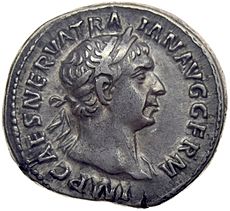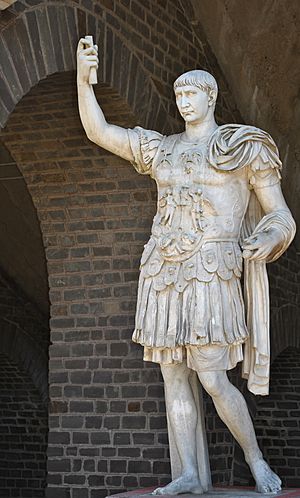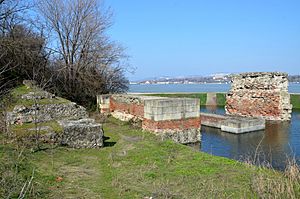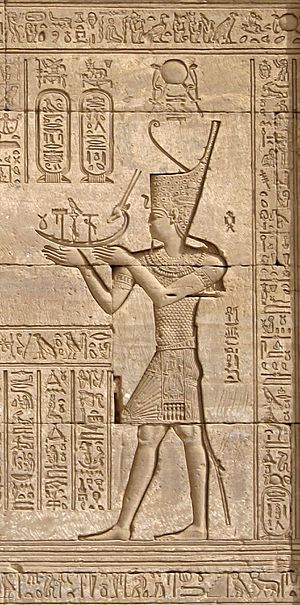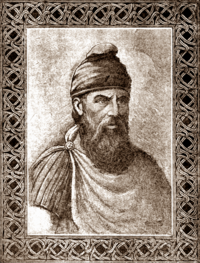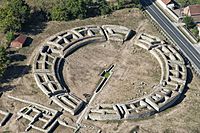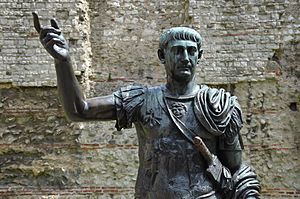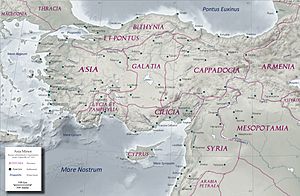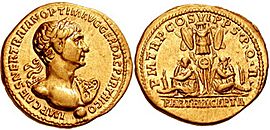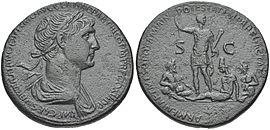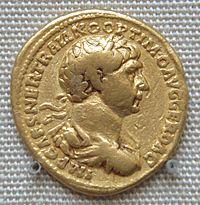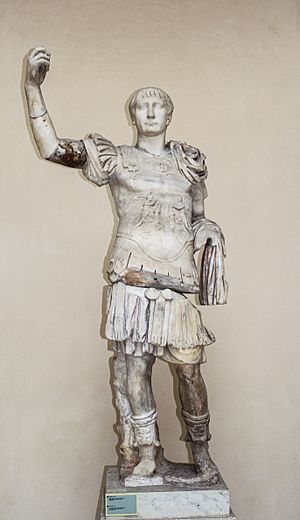Trajan facts for kids
Quick facts for kids Trajan |
|||||
|---|---|---|---|---|---|
| Optimus Princeps | |||||
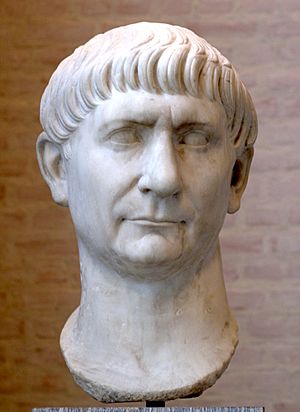
Marble bust, Glyptothek, Munich
|
|||||
| Roman emperor | |||||
| Reign | 28 January 98 – 11 August 117 | ||||
| Predecessor | Nerva | ||||
| Successor | Hadrian | ||||
| Born | Marcus Ulpius Traianus 18 September 53 Italica, Hispania Baetica (now Santiponce, Spain) |
||||
| Died | August (unknown specific date) 117 (aged 63) Selinus, Cilicia (now Gazipaşa, Turkey) |
||||
| Burial | Rome (ashes of Trajan's Column, now lost), now known as Trajan's Forum | ||||
| Spouse | Pompeia Plotina | ||||
| Adoptive children |
|
||||
|
|||||
| Dynasty | Nerva–Antonine | ||||
| Father |
|
||||
| Mother | Marcia | ||||
Trajan (/ˈtreɪdʒən/ TRAY-jən; Latin: Caesar Nerva Traianus; 18 September 53 – 9/11 August 117) was a powerful Roman emperor who ruled from 98 to 117 AD. The Roman Senate called him optimus princeps, meaning "best ruler." He was known as a successful soldier and leader.
Under Trajan, the Roman Empire grew to its largest size ever. He also cared about his people. He started many public building projects and social programs. These actions made him famous as one of the "Five Good Emperors." This period was a time of peace and wealth for the Roman Empire.
Trajan was born in Italica, a Roman town near modern Seville, Spain. His family, the Ulpii, came from Umbria, Italy. His father was a senator, so Trajan grew up in a well-known family.
Trajan became important during the rule of Emperor Domitian. He was a military commander and helped Domitian stop a revolt. Domitian's successor, Nerva, was old and not popular with the army. After a difficult year, Nerva adopted Trajan as his heir. When Nerva died in 98 AD, Trajan became emperor without any problems.
Trajan's building projects changed the city of Rome. He built Trajan's Forum, Trajan's Market, and Trajan's Column. Early in his rule, he took over the Nabataean Kingdom, creating the province of Arabia Petraea. His conquest of Dacia (modern-day Romania) brought a lot of gold to the empire. Trajan also fought against the Parthian Empire. He captured its capital, Ctesiphon, and added Armenia and Mesopotamia to Rome.
In late 117 AD, Trajan became sick while sailing back to Rome. He died from a stroke in Selinus, a city in modern Turkey. The Senate declared him a god. His cousin and chosen successor, Hadrian, became the next emperor. Trajan's ashes were placed in a small room under Trajan's Column.
Contents
Early Life and Family
Marcus Ulpius Trajanus was born on September 18, 53 AD. His birthplace was Italica, a Roman town in what is now Spain. At that time, Italica was a small town.
Some ancient writers said Trajan was the first emperor not from Italy. However, Trajan's family came from Umbria, Italy. They were among the first settlers of Italica. So, modern historians believe Trajan's family was indeed of Italian origin.
Trajan's mother was Marcia, a Roman noblewoman. His father, Marcus Ulpius Trajanus, was a famous senator and general. His father fought in the First Jewish–Roman War.
We don't know much about Trajan's early years. He likely spent his first years in Italica. Then he moved to Rome. He might have returned to Italica later when his father was governor there. His family built strong connections with other important families in Rome and Spain.
The Trajan family home in Rome was on the Aventine Hill. Archeologists believe they found parts of their large villa there. It had beautifully decorated rooms.
Military Career
As a young man, Trajan became a soldier in the Roman army. He served in important border areas of the Empire. In 76-77 AD, his father was governor of Syria. Trajan served there as a military leader. He also served in a province along the Rhine River. He likely fought in battles during these times.
Around 86 AD, Trajan became a guardian for his young cousins, Hadrian and Paulina. Hadrian later became emperor after Trajan.
In 91 AD, Trajan became a Consul. This was an important position, usually for older, very experienced people. His father's high rank likely helped him get this early appointment. Around this time, Trajan brought a skilled architect, Apollodorus of Damascus, to Rome. He also married Pompeia Plotina, a noblewoman. They did not have children.
In 89 AD, Trajan helped Emperor Domitian stop a rebellion. He was a commander of a legion in Spain. He likely stayed in the area to fight tribes who had supported the rebels. He then returned his legion to Spain.
How Trajan Became Emperor
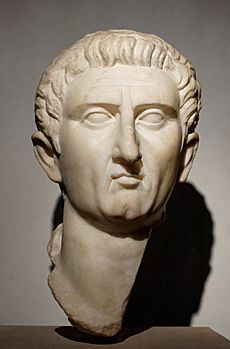
After Domitian was killed, Nerva became emperor. But Nerva was not popular with the army. He needed their support to stay in power. In 97 AD, Nerva adopted Trajan as his son and successor. He said this was because of Trajan's great military skills. Some sources suggest Nerva was pressured to adopt Trajan.
The future Emperor Hadrian brought the news of his adoption to Trajan. Trajan kept Hadrian as a military officer on the Rhine border. Hadrian became part of Trajan's close group of friends and advisors. One important advisor was Lucius Licinius Sura, who was very influential.
As governor of Upper Germany, Trajan earned the title Germanicus. This was for his good leadership of the province. When Nerva died on January 28, 98 AD, Trajan became emperor. He did not rush to Rome. Instead, he toured the Rhine and Danube borders. This showed he understood the importance of strong borders. He also ordered the execution of Nerva's Praetorian Prefect, Aelianus. This suggests Trajan's rise to power was a strong move rather than just a peaceful handover.
Trajan as Emperor
When Trajan entered Rome, he gave money to the common people. He also reduced the traditional gift to the soldiers by half. He worked to improve relations with the Roman Senate. He pretended to be unwilling to take power. This helped him gain support from the Senate. His entry into Rome in 99 AD was simple and humble. This made him seem like a traditional Roman leader.
In a speech in 100 AD, Trajan asked the Senate to help him rule the Empire. But in reality, Trajan kept most of the power. He took over some areas that the Senate used to control. For example, he made Achaea and Bithynia into imperial provinces. This was to fix problems with spending and management there.
"The Best Ruler"
Trajan was seen as a "good" emperor because he acted in ways the Senate would approve. He ruled with moderation, not with harshness. He was a role model for others. His popularity grew so much that the Roman Senate gave him the special title optimus, meaning "the best." This title appeared on coins starting in 105 AD. It showed his role as a great leader and helper of the people.
Trajan brought back many people who had been exiled by Domitian. He also returned much private property that Domitian had taken. This made him popular with the educated elite. However, Trajan made it clear that Greek intellectuals were tools for local administration. They were not to be treated as equals to Roman rulers.
Trajan was careful about independent political activity. He stopped the city of Nicomedia from having a fire department. He worried that groups of people would turn into political societies. He also worried about rich locals giving away too much money or gifts.
Trajan also allowed some important Eastern leaders to join the Senate. This was unusual, as the Senate was traditionally Roman. These new senators were often very wealthy and powerful. This shows that Trajan was open to including people from different parts of the Empire.
Building Projects
Trajan was a very active builder. Many of his projects were designed by the talented architect Apollodorus of Damascus. One of his most impressive works was a huge bridge over the Danube River. This bridge allowed the Roman army to move easily, no matter the weather. Trajan also improved roads along the Iron Gates gorge.
Trajan's Forum Traiani was the largest forum in Rome. It was built to celebrate his victories in Dacia. The project was paid for with treasure from the Dacian campaign. To build it, parts of the Capitoline Hill and Quirinal Hill had to be removed. The forum included a grand entrance arch, a large open space, a huge basilica, and later, Trajan's Column and libraries. It was started in 107 AD and finished in 112 AD. It was used for over 500 years.
Trajan also built many triumphal arches. He built new roads, like the Via Traiana. This road extended the Via Appia from Beneventum to Brundisium. He also built the Via Traiana Nova, a military road from Damascus to Aila. This road helped Rome take over Nabataea.
Some historians believe Trajan built or rebuilt the Roman fortress in Old Cairo. He may also have built a canal between the Nile River and the Red Sea. In Egypt, Trajan built and decorated many buildings. His image appears on the Temple of Hathor at Dendera. His name is also on columns at the Temple of Khnum at Esna.
He also built two large villas outside Rome.
Public Entertainment and Welfare
Trajan spent a lot of money on public entertainment. He rebuilt the Circus Maximus, Rome's largest arena for chariot racing. The Circus also hosted religious shows and public parades. Trajan's changes, finished by 103 AD, made the Circus even bigger. It replaced wooden seats with stone and added about 5,000 more seats.
Around 108 or 109 AD, Trajan held 123 days of games to celebrate his victory in Dacia. These games included 10,000 gladiators. Thousands of animals were also killed. Trajan believed that public entertainment kept people happy. He also made sure people received grain.
In 107 AD, Trajan changed the value of Roman money. He reduced the silver in the denarius coin. This, along with the gold and silver from his wars, allowed him to make more coins. He also started the alimenta, a welfare program. This program helped orphans and poor children in Italy. It provided them with money, food, and education. The program was funded by war treasures and taxes.
Military Campaigns
Conquering Dacia
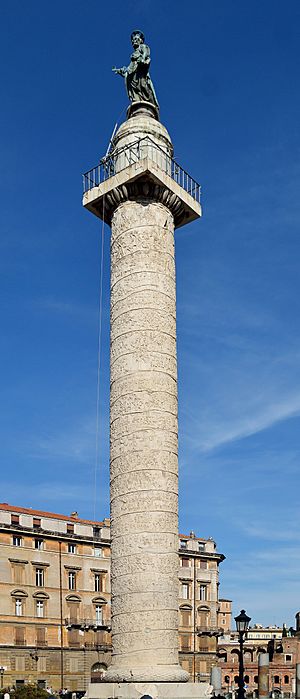
Trajan led the Roman Empire to its largest size. His first major conquests were two wars against Dacia. Dacia was a powerful kingdom that had caused problems for Rome. In the first war (101-102 AD), Trajan made Dacia a client kingdom of Rome. In the second war, Dacia became a Roman province.
Before Trajan, Dacia's king, Decebalus, had a treaty with Rome. He was a client king and received money and experts from Rome. But the Roman Senate disliked paying what they saw as tribute to a "barbarian" king. Dacia was a strong, organized state. This made it a threat to Rome.
In May 101 AD, Trajan began his first campaign into Dacia. He crossed the Danube River and defeated the Dacian army. The battle was difficult, and Rome suffered losses. Trajan regrouped his army. The battle was still a Roman victory. Trajan's Column shows him capturing Decebalus' sister.
The next winter, Decebalus attacked Roman territory. Trajan's army pushed back the Dacians and their allies. Then, Trajan advanced deeper into Dacia. A year later, he forced Decebalus to surrender. Decebalus had to give up some land and all his war machines. Trajan returned to Rome in triumph and was given the title Dacicus.
But Decebalus soon began to rearm and seek new allies. He tried to have Trajan killed. He also captured a Roman general, who later poisoned himself. In 105 AD, Decebalus invaded Roman territory.
Trajan raised two new legions for the second war. By 105 AD, about half of the entire Roman army was on the Danube frontier. The Roman forces were between 150,000 and 175,000 soldiers. Decebalus had up to 200,000.
The second Dacian War was fierce. The Dacians stayed in their fortresses, and the Romans attacked them. The Romans slowly surrounded Decebalus' main stronghold, Sarmizegetusa Regia. They finally captured and destroyed it. Decebalus fled but was later cornered by Roman cavalry. He died rather than be captured.
The Dacian treasures were found later. A Dacian nobleman revealed that they were buried under a diverted river. Huge amounts of gold and silver were sent to Rome.
Trajan built a new city, Colonia Ulpia Traiana Augusta Dacica Sarmizegetusa. This city became a civilian center for the new Roman province. Roman colonists, mostly retired soldiers, lived there. Native Dacians continued to live in rural areas.
The defense of Dacia was given to one legion, the Legio XIII Gemina. This legion was stationed at Apulum. It could strike at enemies to the west or east. The province was seen as a base for future attacks. Dacia was a valuable province because of its gold mines. These mines were managed by a Roman official.
The victory was celebrated with the Tropaeum Traiani monument in Moesia. It was also shown on Trajan's Column in Rome. The column has detailed carvings of the Dacian Wars.
Taking Over Nabataea
In 106 AD, Rabbel II Soter, a client king of Rome, died. This led to Rome taking over the Nabataean Kingdom. The exact reasons are not fully clear. But by 107 AD, Roman legions were in the area around Petra and Bosra. The Roman Empire gained the province of Arabia Petraea (modern Jordan and northwest Saudi Arabia).
A new Roman road, the Via Traiana Nova, was built. It went from Aila on the Red Sea to Bosrah. Nabataea was the last client kingdom in Asia west of the Euphrates River. Its annexation meant that all of the Roman East was now under direct Roman rule.
War with Parthia
In 113 AD, Trajan started his last major campaign. This was against the Parthian Empire. Parthia had put a new king on the throne of Armenia. Armenia was a kingdom that Rome and Parthia had shared control over for 50 years. Trajan refused to make peace with the Parthians.
Historians debate why Trajan went to war with Parthia. Some believe it was for economic reasons. After taking over Arabia, Trajan built a new road to the Red Sea. This meant that Charax, a city on the Persian Gulf, was the last major trade point not under Roman control. Controlling it could lower import prices for goods from the Far East.
Trajan had used Syrian soldiers in his Dacian wars. He also recruited soldiers from Palmyra. This suggests he wanted to control trade routes. Some believe that by taking Armenia, he needed to take all of Mesopotamia. This would prevent Parthia from stopping trade or causing trouble on the Roman border.
Other historians disagree. They say Parthian control over trade was not clear. They also say that Rome was not focused on economic policy in the way modern countries are. They believe Trajan's war was about gaining land and prestige. It was a chance to be like Alexander the Great.
The campaign was carefully planned. Ten legions were sent to the East. Local officials had to organize supplies for the troops. This made the campaign very expensive from the start. Trajan first marched into Armenia. He removed the Parthian-appointed king and made Armenia a Roman province. He also gained control over tribes in the Caucasus and Black Sea region.
In early 115 AD, Trajan launched his Mesopotamian campaign. He moved to secure the land between the Tigris and Euphrates rivers. He placed permanent garrisons to protect the territory. Roman armies moved from different directions. They took northern Mesopotamian cities like Nisibis and Batnae. They also made the Kingdom of Osrhoene a Roman protectorate. By early 116 AD, coins announced that Armenia and Mesopotamia were under Roman control.
After spending the winter in Antioch, Trajan continued his campaign in 116 AD. He aimed to conquer all of Mesopotamia. This was a very ambitious goal. One Roman army crossed the Tigris River and captured Adenystrae. Another followed the river south and captured Babylon. Trajan himself sailed down the Euphrates River. He then moved his fleet overland to the Tigris. He captured Seleucia and the Parthian capital, Ctesiphon.
He continued south to the Persian Gulf. He received the surrender of Athambelus, the ruler of Charax. Trajan declared Babylon a new Roman province. He had his statue placed on the Persian Gulf shore. He told the Senate the war was over. He said he was too old to continue and repeat Alexander the Great's conquests. The Parthian city of Susa was also occupied by the Romans.
A province called Assyria was also declared. This likely covered the area of Adiabene. Trajan might have planned to control trade with India. But local resistance against Roman rule began.
Trajan left the Persian Gulf for Babylon. But a revolt led by Sanatruces threatened Roman positions. Trajan decided to change his strategy. He sent two armies to Northern Mesopotamia. One army, led by Lusius Quietus, recaptured Nisibis and Edessa. The other army was defeated.
Later in 116 AD, Trajan, with his generals, defeated a Parthian army. Sanatruces was killed. Trajan then removed the Parthian king, Osroes, and put Parthamaspates on the throne as a client ruler. This was shown on a coin that said, "a king is given to the Parthians." Trajan then retreated north to keep control of Armenia and Mesopotamia. At this point, Trajan's health began to fail. The city of Hatra resisted Roman attacks. Trajan was present at the siege and may have suffered from heat stroke.
Kitos War
Soon after, Jewish communities in the Eastern Roman Empire rebelled. This was called the Kitos War. Another rebellion started among Jewish communities in Northern Mesopotamia. Trajan had to pull his army back to stop these revolts. He saw this as a temporary setback. But he never commanded an army in the field again. He gave control of his Eastern armies to Lusius Quietus. Quietus successfully put down the revolts. The war was later named after him.
Quietus was promised a high position for his victories. But he was killed before this could happen. This happened during a bloody purge at the start of Hadrian's rule. Quietus and three other former consuls were executed. It is thought that Hadrian ordered their deaths. He feared their popularity with the army and their close ties to Trajan.
Death and Succession
In early 117 AD, Trajan became ill and sailed for Italy. His health got worse throughout the spring and summer. He died suddenly in Selinus, likely on August 11. He probably died from swelling.
Trajan could have officially named Hadrian as his successor. But some sources say Trajan's wife, Pompeia Plotina, made sure Hadrian became emperor. She kept Trajan's death a secret for a while. She then produced a document saying Trajan had adopted Hadrian as his son and successor. This story might show that some Romans disliked women being involved in politics.
Hadrian's position during Trajan's rule was unclear. He had served in the Dacian Wars. But he was sent away from the front lines during the second war. He had a normal senatorial career. He was not officially adopted by Trajan, but he received honors that made him hope for the succession. Some sources say Trajan considered other people as his heir.
Hadrian was Trajan's cousin. He was also married to Trajan's grandniece. This made him a strong candidate for heir. Hadrian was well connected to powerful Spanish senators at Trajan's court. He was close to Plotina and the Prefect Attianus.
Hadrian's first major act as emperor was to give up Mesopotamia. He thought it was too expensive and hard to defend. He also returned Armenia and Osrhoene to Parthian control, but under Rome's influence. The Parthian campaign had been a big problem for Trajan. It showed that Rome had tried to conquer too much. Other lands conquered by Trajan were kept. Trajan's ashes were placed at the base of Trajan's Column.
Legacy
Ancient writers always spoke positively about Trajan. Pliny the Younger called him a wise, fair, and moral emperor. Cassius Dio said he was always dignified and just. Later, a third-century emperor, Decius, was even given the name Trajan as an honor. After the problems of the Crisis of the Third Century, Trajan became a symbol of good rule.
Some religious thinkers, like Thomas Aquinas, saw Trajan as an example of a good non-Christian. In the Divine Comedy, Dante places Trajan's spirit in Heaven. This is because of his justice. A painting of Trajan helping a poor widow is also in Purgatory. It teaches a lesson about humility.
Later Emperors
Many emperors after Trajan were wished, Felicior Augusto, Melior Traiano. This means "May you be more fortunate than Augustus and better than Trajan." Constantine I said Trajan was like "a plant upon every wall." This was because of the many buildings with his name.
After Rome
In the 18th century, King Charles III of Spain asked Anton Raphael Mengs to paint The Triumph of Trajan. This painting is on the ceiling of the banquet hall in the Royal Palace of Madrid.
Later, in the Age of Enlightenment, some historians questioned Trajan's legacy. Edward Gibbon doubted Trajan's military focus. He preferred the more moderate emperors who came after. Theodor Mommsen called Trajan's desire for conquest "insatiable." He thought Hadrian was right to give up Trajan's conquests.
In the early 20th century, some historians, like Roberto Paribeni, praised Trajan. They saw his rule as the peak of the Roman Empire. Alfred Heuss called Trajan "the ideal embodiment of the humane emperor." Julian Bennett's biography of Trajan also saw him as an active leader.
More recently, historians have had different views. Eugen Cizek described Trajan's rule as becoming more autocratic and military-focused. Karl Strobel said Trajan's rule was similar to Domitian's. He saw the Parthian war as a failed personal goal. French historians like Paul Petit and Paul Veyne have been more critical. They see Trajan as the last emperor who thought of the empire as only about Italy and conquest. Hadrian, his successor, saw the empire as more global.
In Jewish Legend
In some Jewish stories, Trajan is described with the phrase "may his bones be crushed." This phrase is also used for Hadrian.
See also
 In Spanish: Trajano para niños
In Spanish: Trajano para niños
- Felicior Augusto, melior Traiano
- Justice of Trajan
- Trajanic art


